Physical Address
304 North Cardinal St.
Dorchester Center, MA 02124
The term reactive erythema refers to a group of disorders characterized by erythematous patches, plaques, and nodules that vary in size, shape, and distribution. Unlike other specific and intrinsic dermatoses, these represent cutaneous reaction patterns triggered by a variety of either endogenous triggers or environmental agents. In children, the most common reactive erythemas include drug eruptions, urticaria, viral exanthems, erythema multiforme (EM), erythema nodosum (EN), vasculitis, photosensitive eruptions, and collagen vascular disorders. An algorithmic approach to diagnosis for reactive erythema is summarized at the end of the chapter (see Fig. 7.58 ).
Of all patients admitted to hospital, approximately 27% experience an adverse drug reaction (ADR) and ~0.1–0.3% will experience a fatal ADR. Approximately half of ADRs will result in cutaneous findings. Drug-induced rashes are also a frequent diagnostic problem in the outpatient setting. Although the skin rash often occurs alone, it may be accompanied by fever, arthritis, and other systemic findings. The incidence of drug reactions increases with age and the number of medications used. Paradoxically, patients with hereditary or acquired immunodeficiency appear to be particularly prone to developing reactions from medications. For example, nearly 75% of human immunodeficiency virus–infected patients develop morbilliform eruptions from sulfonamides during their illness.
The overwhelming majority of medication-induced rashes are morbilliform. Depending upon the study population, 50–94% of patients with cutaneous ADR will present with this classic rash. The remainder of the rashes are urticarial in 25%, fixed drug reactions in 10%, and exfoliative erythroderma, Stevens–Johnson syndrome (SJS)/toxic epidermal necrolysis (TEN), vasculitic, lichenoid, and acneiform eruptions in less than 5% each. Early recognition of drug-related rashes and discontinuation of the inciting agent may prevent progressive, life-threatening complications and certainly reassure patients, parents, and practitioners.
Morbilliform (measles-like, maculopapular, exanthematous) rashes account for the majority of drug-induced rashes. Typically, after 1–2 weeks of drug therapy, red macules and papules erupt on the extremities and spread centrally to involve the trunk. Not infrequently, however, the trunk is the first area to be involved and the rash spreads centripetally ( Fig. 7.1 ). Lesions may become confluent, but the perioral and perinasal areas are often spared. Conjunctival and oral mucosal erythema may be prominent. Although the rash can be asymptomatic, pruritus is common and may be severe. The skin may be the only organ system involved, but fever, arthralgias, and general malaise may follow. Occasionally, the rash resolves despite continuation of the medication, and rarely, eruptions evolve into SJS/TEN with widespread necrosis of the epidermis.
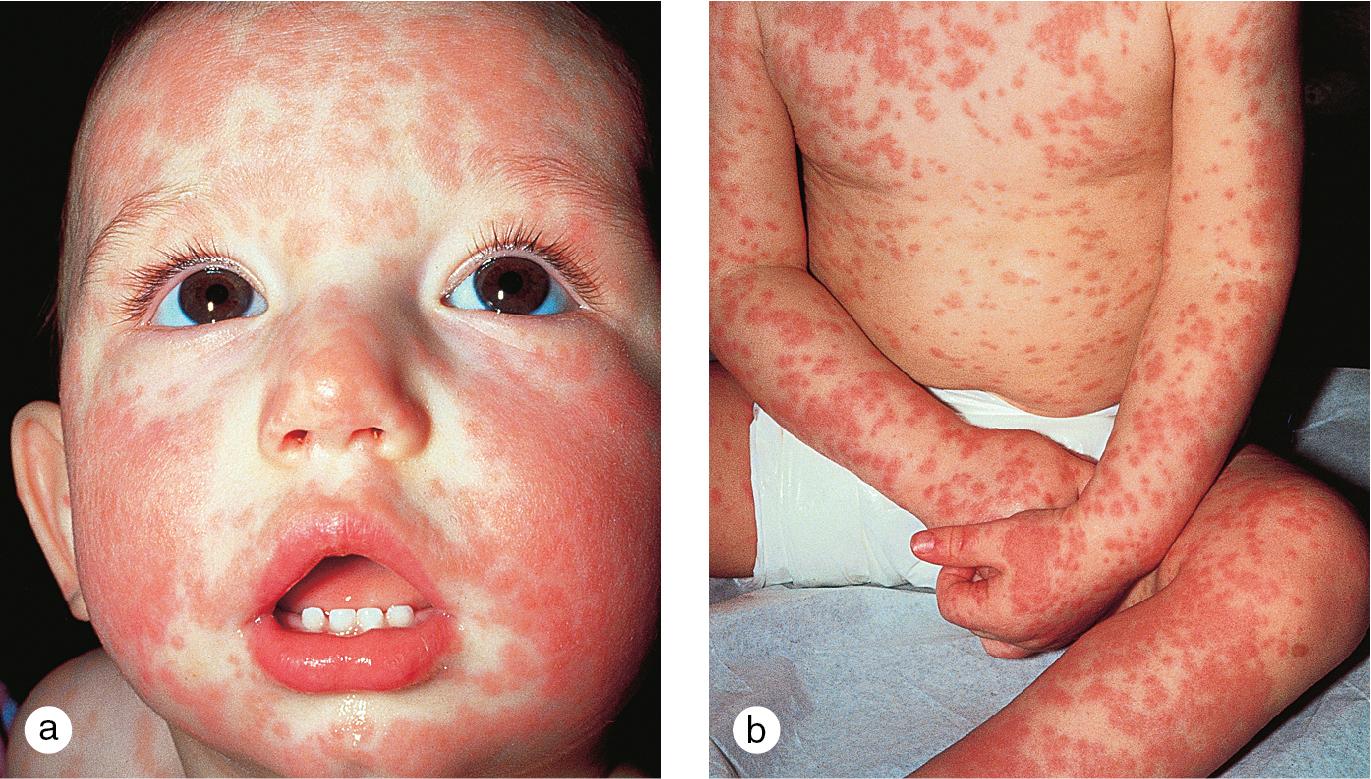
Almost any drug can trigger a morbilliform rash. Common categories include antibiotics, anticonvulsants, and antihypertensives. Prompt diagnosis and discontinuation of the drug usually result in improvement in 1–2 days and resolution within 1 week. Occasionally, the rash does not appear until several days after the drug course has been completed.
Patients with a simple morbilliform drug rash can often be treated with discontinuation of the offending medication, topical steroids as needed, and supportive care. It is advised that the patient avoid the offending medication in the future to prevent recurrence of the reaction.
Drug rash with eosinophilia and systemic symptoms (DRESS)/drug-induced hypersensitivity syndrome (DIHS) usually begins with a morbilliform eruption 2–6 weeks after initiation of the inciting medication. This timeline is important to keep in mind when evaluating a new patient with a cutaneous ADR, as DRESS/DIHS can have significantly higher morbidity and mortality compared with a simple morbilliform drug rash. Lesions first appear on the face, upper trunk, and proximal extremities, often with follicular accentuation, and disseminate quickly. Skin edema may be intense, resulting in the formation of vesicles, bullae, and pustules. Early clues to diagnosis are significant facial edema and widespread lymphadenopathy. High fever and multisystem involvement defines this disorder, and it should be suspected in any patient with morbilliform rash, fever, facial edema, and lymphadenopathy. Hepatitis (which may rarely be fulminant), generalized lymphadenopathy, myocarditis, pneumonitis, nephritis, thyroiditis (including a delayed thyroiditis months after a patient recovers from DRESS/DIHS), and meningoencephalitis may develop. Laboratory testing will often show atypical lymphocytes and eosinophilia, although these are not always present.
This condition is most often triggered by aromatic anticonvulsants (phenytoin, carbamazepine, and phenobarbital), lamotrigine, allopurinol, sulfonamides, dapsone, and other antibiotics. Although the pathogenesis of DRESS/DIHS is not fully understood, the reaction is thought to occur in genetically predisposed individuals who have a reduced capacity to metabolize medication metabolites. Toxic metabolites accumulate and activate T-lymphocytes, which drive the immunologic process, including eosinophilic infiltration of the skin and viscera. Interestingly, reactivation of viruses including human herpesvirus 6 (HHV6) and HHV7 in patients with DRESS/DIHS also supports an immunologic mechanism and perhaps a drug–viral interaction. Some centers have even begun to use serologic positivity for HHV6 and/or HHV7 as evidence for diagnosing a patient with DRESS/DIHS. Immediate discontinuation of the inciting medication is critical, and systemic steroids may be required to shut off the disorder, which may last for weeks to months ( Fig. 7.2 ).
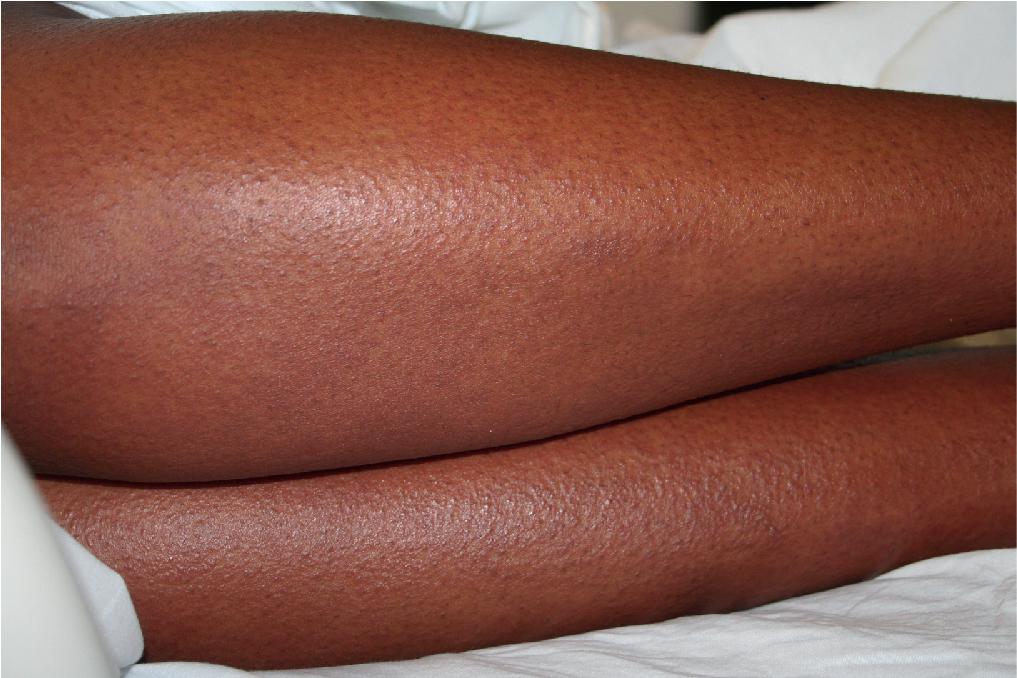
Unfortunately, morbilliform rashes often appear in febrile children who are placed on antibiotics for treatment of presumed bacterial infections such as sinusitis and otitis media. The differentiation of a viral infection with associated exanthem from a drug rash is usually impossible, and many of these children are labeled antibiotic allergic. In some patients, recognition of specific viral exanthems and serologic confirmation support an infectious etiology. Moreover, some drugs may interact with certain viruses to produce an exanthem such as the rash seen in up to 95% of children with mononucleosis who are treated with ampicillin ( Fig. 7.3 ). The differential diagnosis also includes graft-vs-host disease and Kawasaki syndrome, but the medical history and associated findings help to exclude these disorders. Histologic findings in morbilliform drug reactions overlaps with viral exanthems and graft-vs-host disease, so skin biopsies usually do not help to distinguish these disorders.
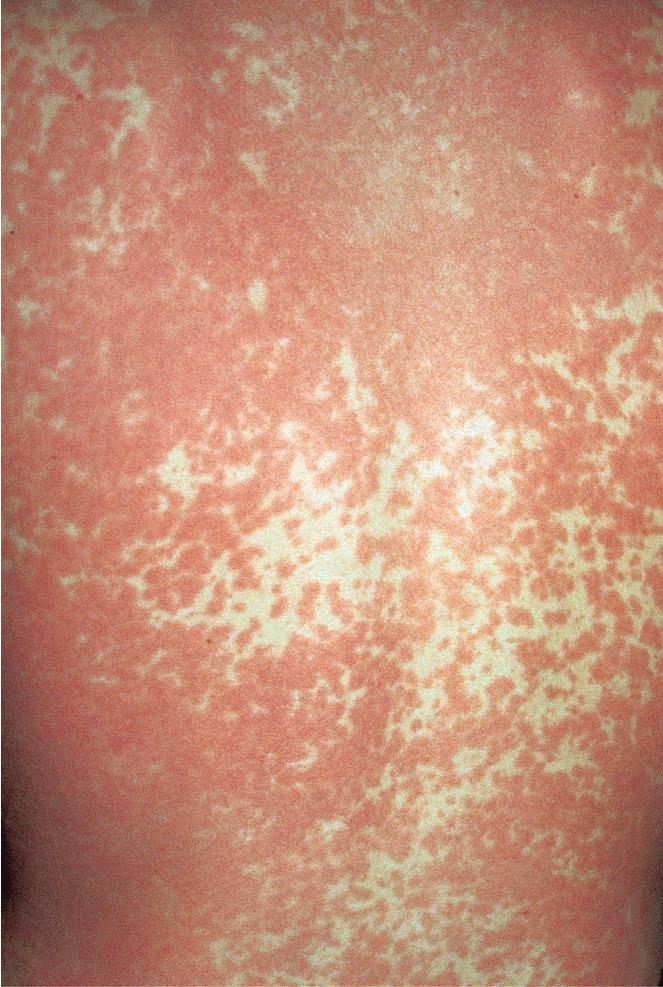
Although SJS and TEN were initially thought to represent severe variants of EM, further studies support the clinical separation of EM and SJS/TEN. Although SJS/TEN may be triggered by drugs and a number of other infectious and biological agents, EM has been most commonly associated with infectious agents, particularly herpes simplex virus and mycoplasma infections, in children and adults. SJS/TEN are defined by a severe mucositis of multiple mucous membranes and variable cutaneous involvement which may be life-threatening. SJS is distinguished by the amount of body surface area affected, with up to 10% in SJS, 10–30% in SJS/TEN overlap, and over 30% in TEN. It is important to contrast key clinical findings that distinguish SJS/TEN from EM, as the clinical prognosis for SJS/TEN is much worse (mortality for SJS/TEN can range from 5% to 95% based upon clinical features). In contrast to SJS/TEN, which commonly spares the palm and soles and consists of flat lesions, EM presents with characteristic raised targetoid lesions on the distal extremities. Additionally, although SJS/TEN and EM both can affect oral mucous membranes, the oral lesions in SJS/TEN are typically much more severe, more common, and persistent. Although SJS/TEN is rare, the clinician must recognize these clinical patterns early to avoid or effectively deal with potentially serious complications. Classic EM, SJS, and TEN are described in Chapter 4 .
Fixed drug eruption is a distinctive reaction pattern characterized by the sudden onset of one or several EM-like annular, erythematous, edematous plaques ranging in size from 1 cm to over 5 cm in diameter. Lesions will typically recur in the same location when a patient is challenged with the causative medication. Lesions occur after exposure to a number of medications ( Fig. 7.4 ). Lesions typically take a few days to develop after first-time medication exposure, but on subsequent exposure can develop in as little as 30 min. Intense edema may result in bulla formation. When the drug is withdrawn, lesions flatten, erythema fades, and prominent post-inflammatory hyperpigmentation persists for weeks to months. On re-exposure to the allergen, old lesions reappear and new plaques may develop and slowly progress. Widespread bullous eruptions rarely occur with recurrent exposure to the offending agent.
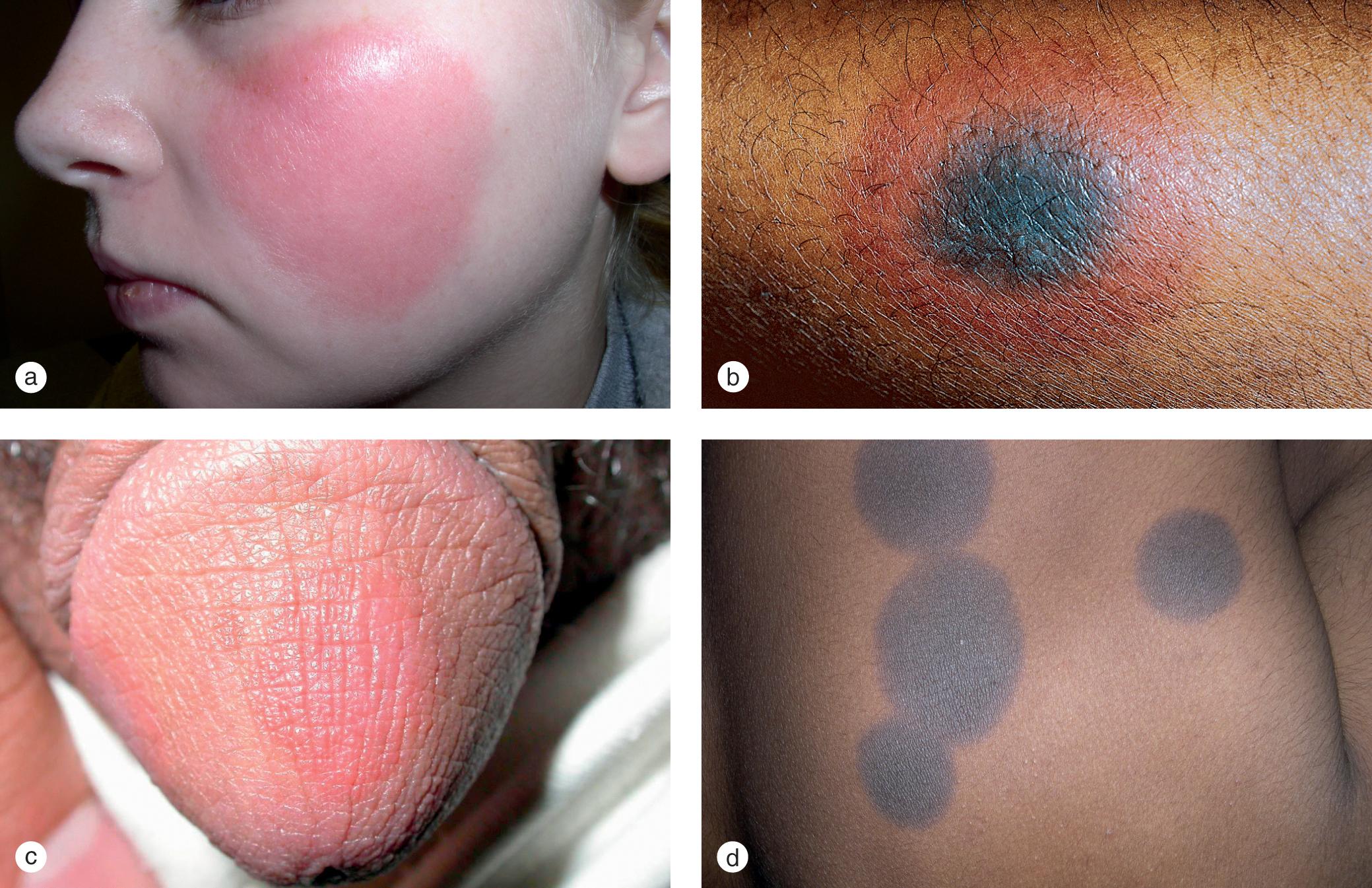
Although the rash may develop on any site, the face, lips, genitals, and buttocks are the most commonly involved. The most frequent triggering agents include trimethoprim-sulfamethoxazole, aspirin, tetracyclines, barbiturates, and non-steroidal anti-inflammatory drugs.
Although the mechanism is not known, T-lymphocytes that reside in the dermis and amplification by T-cells recruited from the circulation are thought to be responsible for the acute reaction, as well as the cutaneous memory function of the fixed drug eruption. Suppressor/cytotoxic T-lymphocytes recognize drug-haptens, which bind to proteins in basal keratinocytes and melanocytes to form a complete antigen, which stimulates the immunologically mediated process. Histologic findings are similar to those of EM, but pigment incontinence tends to be intense. This explains the impressive, discrete hyperpigmentation, which may be the only clinical finding between episodes. Once the diagnosis is considered, the allergen can be identified and avoided.
Urticaria, commonly known as hives, is characterized by the sudden appearance of transient, well-demarcated wheals that are usually intensely pruritic, especially when they arise as part of an acute, immunoglobulin (Ig)E-mediated hypersensitivity reaction ( Fig. 7.5 ). Individual lesions usually last several minutes to several hours, but they may rarely persist for up to 24 h. Wheals may have a red center with an edematous white halo or the reverse: an edematous white center with a red halo. Size can vary from a few millimeters to giant lesions over 20 cm in diameter. Central clearing with peripheral extension may lead to the formation of annular, polycyclic, and arcuate plaques that simulate EM and erythema marginatum. The reaction may involve the mucous membranes and can spread to the subcutaneous tissue to produce woody edema known as angioedema ( Fig. 7.6 ). Histopathology usually demonstrates a mild, lymphocytic, perivascular infiltrate with marked dermal edema.
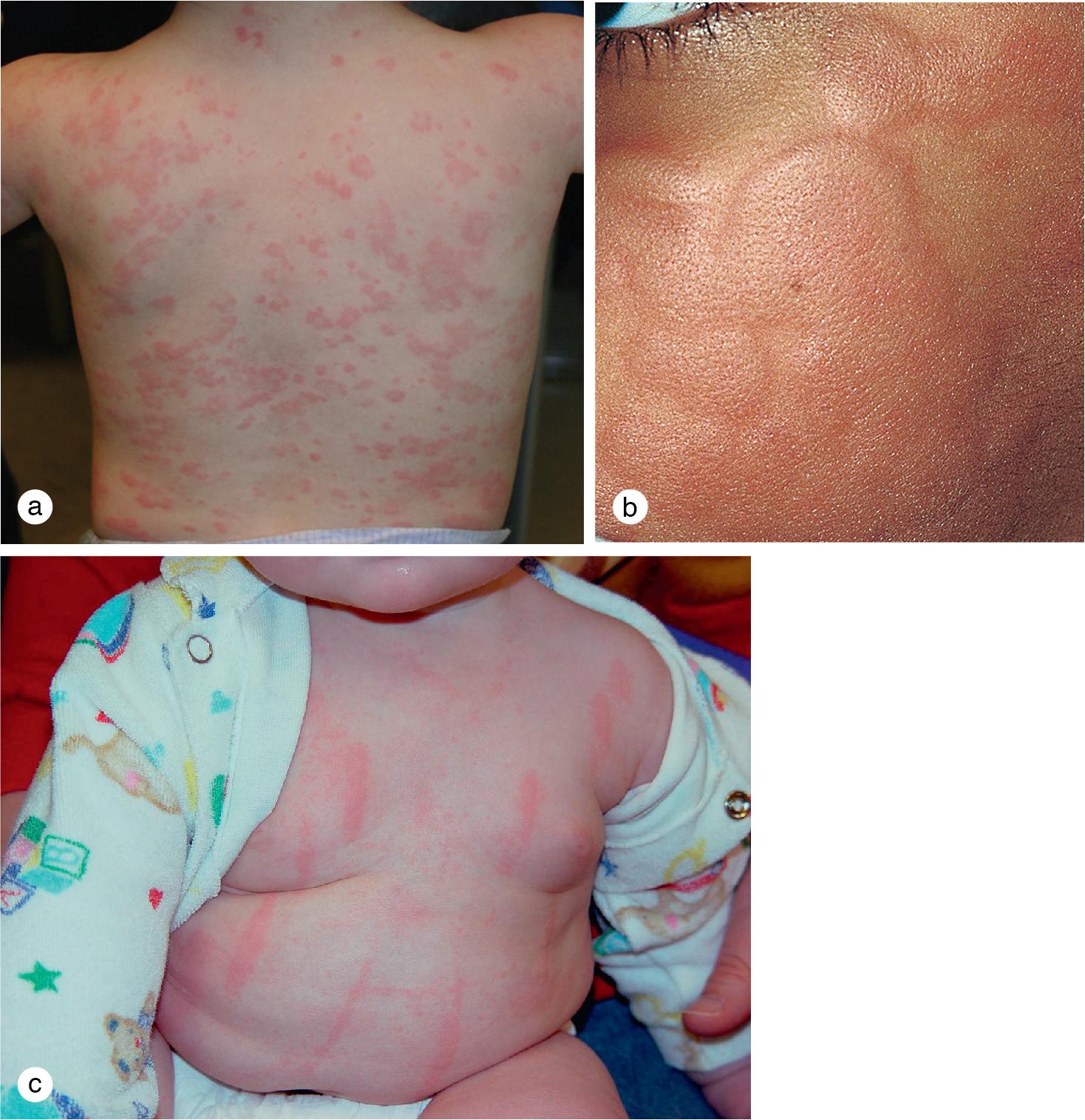
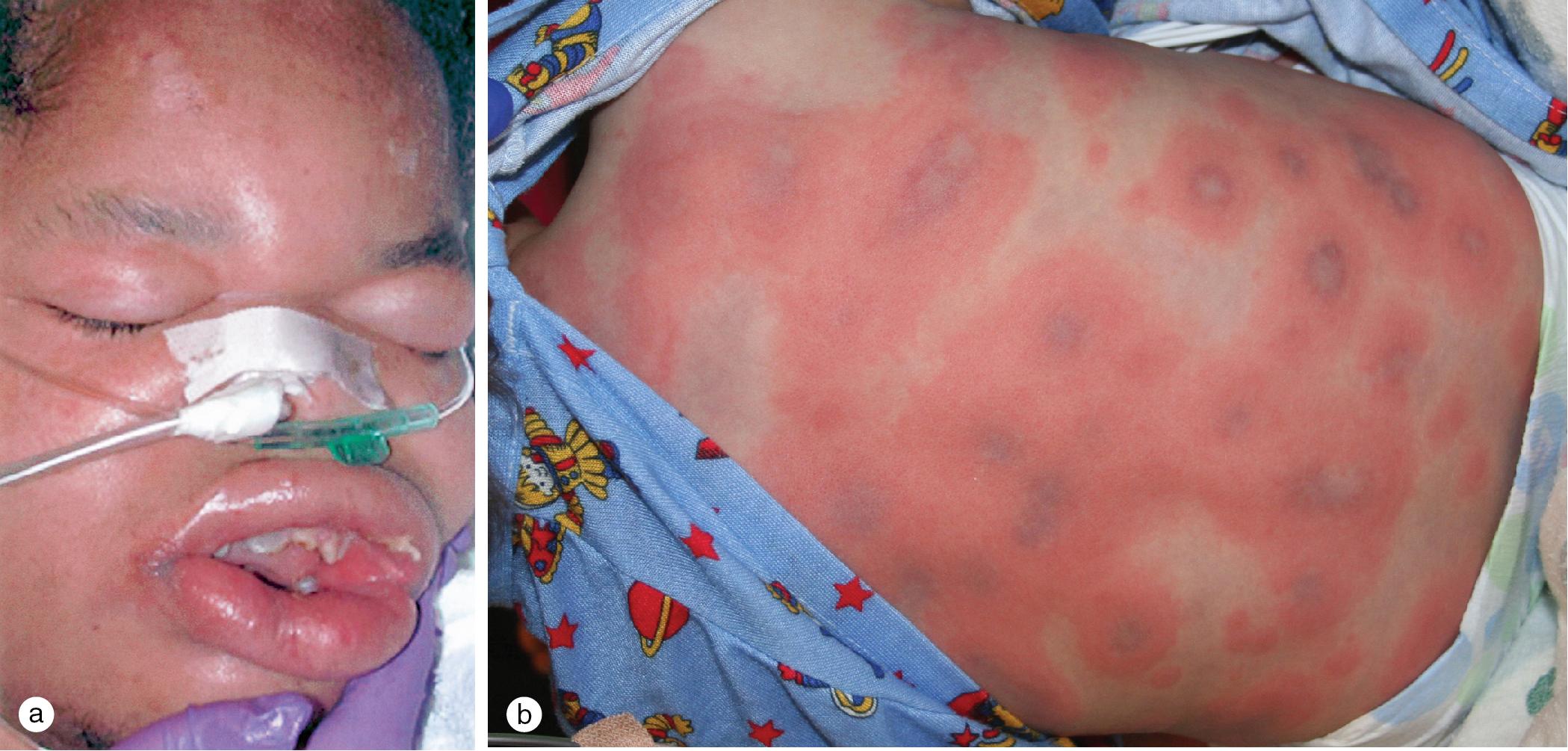
Urticaria can be triggered by a variety of immunologic mechanisms, including IgE antibody response, complement activation, and abnormal response to vasoactive amines. Most cases of acute urticarial—defined as lasting less than 6 weeks—are caused by a hypersensitivity reaction to drugs, food, insect bites, contact antigens, inhaled substances, or acute infections. Physical agents, which include cold, heat, water, exercise, and mechanical pressure, may also trigger hives. Dermatographism or dermatographia (skin writing) refers to a variant of physical urticaria, which occurs in 2–5% of the population and refers to hives triggered by rubbing or scratching the skin. Less than 5% of patients evolve into chronic urticaria, which lasts from 6 weeks to many years. Most commonly chronic urticaria is idiopathic in nature; however, its development has been associated with autoimmune disease and malignancy in adult patients.
Specific drugs and foods known to cause hives should be avoided because of the risk of inducing anaphylaxis on subsequent exposure. Exhaustive laboratory studies in an otherwise healthy child with acute urticaria are unlikely to be rewarding. Laboratory evaluation is guided by findings on history and physical examination. Patients with chronic disease require intermittent re-examination, particularly if other problems such as arthritis, diarrhea, or fever develop.
Extensive urticaria associated with pruritus may respond readily to both sedating H1 antihistamines (e.g., diphenhydramine, hydroxyzine, or chlorpheniramine) and non-sedating H1 antihistamines (e.g., cetirizine, loratadine, desloratadine, and fexofenadine). Dosages should be increased to twice the recommended level or until unacceptable adverse reactions are noted. Most children accommodate quickly to sedation associated with first-generation antihistamines, but many children respond to the non-sedating antihistamines and only require sedating antihistamines for night-time breakthrough symptoms. In resistant cases, the addition of an H2 antihistamine, such as cimetidine or ranitidine, and/or β-adrenergic agonists, such as ephedrine and terbutaline, may be helpful. Adrenaline (epinephrine) may be lifesaving in urticaria and angioedema that involve the airway. Systemic corticosteroids are reserved for patients with life-threatening disease.
Urticarial eruptions may appear early in the course of serum sickness reactions triggered by infectious agents or drugs. Asymptomatic or painful, red papules and expanding annular plaques with hemorrhagic borders are associated with fever, arthralgias, periarticular swelling, and occasionally arthritis. Skin lesions differ from classic urticaria by the lack of pruritus and persistence beyond 24 h. Serum sickness reactions have been reported with cefaclor, but may also occur with a number of other antibiotics ( Fig. 7.7 a). Skin biopsies usually demonstrate a lymphohistiocytic, dermal, inflammatory infiltrate, but occasionally vasculitis may be present.
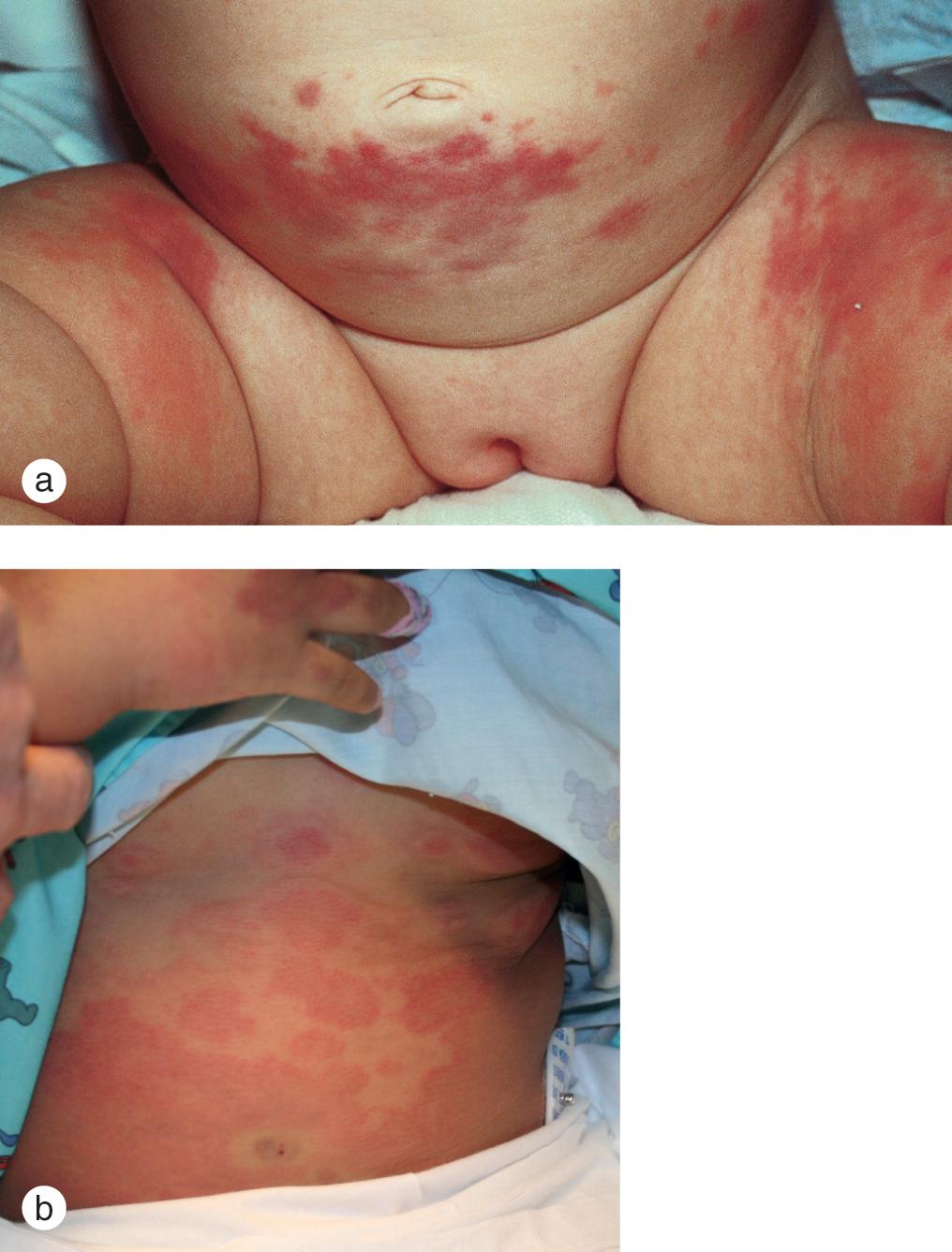
Urticaria may also occur during the prodrome of Henoch–Schönlein purpura, which is characterized by leukocytoclastic vasculitis with palpable purpura. Urticarial-like eruptions triggered by viral infections referred to as urticaria multiforme can be distinguished from serum sickness reactions and EM by the presence of pruritus and a transient, rapidly evolving course. Unlike classic urticaria, individual expanding plaques in urticaria multiforme typically persist for several weeks and often develop a dusky center ( Fig. 7.7 b).
Erythema marginatum, one of the major criteria for rheumatic fever and which occurs in 20% of patients, may be confused with hives. This eruption is characterized by transient, asymptomatic, red papules that enlarge over several hours to form annular, scalloped, and serpiginous expanding plaques with narrow borders and central clearing ( Fig. 7.8 ). Successive crops appear on the trunk and extremities as old plaques fade. New lesions typically flare with evening fever spikes, and involvement is restricted predominantly to the trunk and proximal extremities. The absence of pruritus helps distinguish erythema marginatum from hives, and skin biopsies show predominantly a perivascular neutrophilic infiltrate. The diagnosis of rheumatic fever is dependent on the recognition of other well-defined criteria.
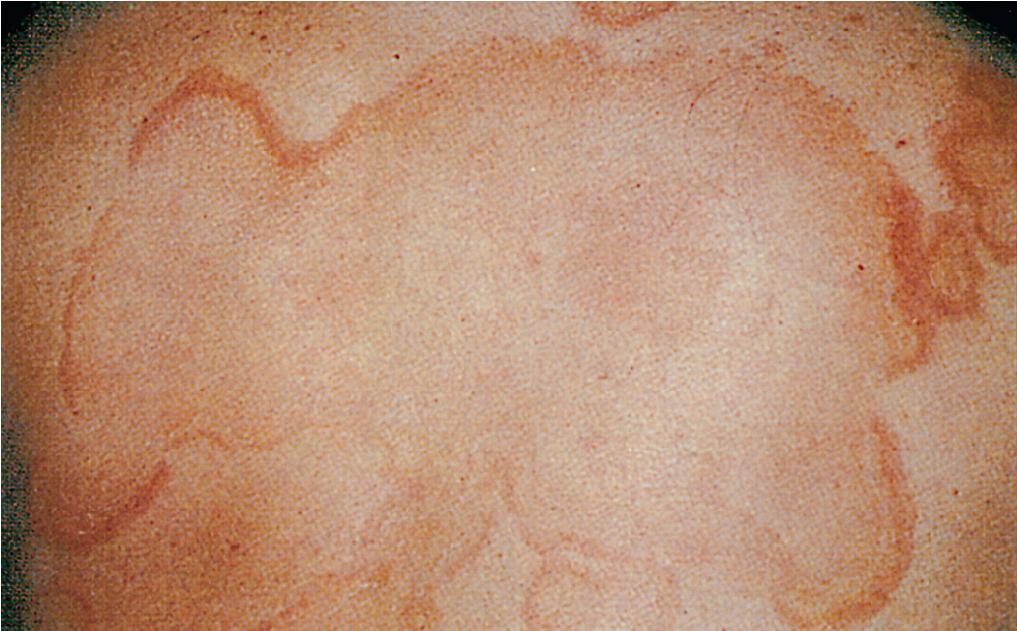
Urticaria must also be distinguished from the figurate erythemas and other reactive erythemas, discussed later in this chapter.
Drugs can also trigger reactions that mimic other cutaneous conditions. In an exfoliative erythroderma, widespread inflammation in the skin is associated with generalized erythema and scale. The entire body surface can be involved, including the scalp, palms, and soles. Although this reaction pattern usually evolves from a primary cutaneous disorder, such as atopic dermatitis, seborrheic dermatitis, psoriasis, or T-cell lymphoma, a number of medications (including allopurinol, barbiturates, captopril, carbamazepine, cimetidine, diltiazem, griseofulvin, gold, thiazide diuretics, isoniazid, hydantoins, D-penicillamine, quinidine, and sulfonamides) have been implicated in some patients. A history of drug exposure, preceding rashes, and associated findings provide clues to the cause of the erythroderma. Histopathology usually reveals a chronic dermatitis. However, the presence of eosinophils may suggest a medication hypersensitivity reaction, while other distinct findings indicate an underlying skin disorder.
In lichenoid drug reactions, clinical findings are usually indistinguishable from those of lichen planus. However, the dermal infiltrate may contain eosinophils, which is unusual for classic lichen planus. Withdrawal of medications may result in improvement of the eruption over weeks to many months. Drugs that have been reported to cause lichenoid reactions include thiazide diuretics, streptomycin, isoniazid, gold, methyldopa, beta-blockers, naproxen, and captopril. Lichenoid drug reactions have also been seen in reaction to anti–tumor necrosis factor (TNF) therapy, as well as tyrosine kinase inhibitors. Lichenoid drug reactions may be difficult to distinguish from graft-vs-host disease in transplant patients.
Acneiform drug reactions may be differentiated from typical acne vulgaris by the presence of uniform, inflammatory papules and pustules (rather than mixed comedones and inflammatory lesions in acne vulgaris); involvement of the usual acne areas (face, shoulders, upper trunk), as well as the lower trunk, arms, and legs; acute onset with introduction of the inciting drug; and resistance to standard therapy. Medications may also exacerbate pre-existing acne. Commonly identified drugs include corticosteroids, corticotropin, isoniazid, lithium, iodides, cyclosporine, and anticonvulsants. Although the eruption may improve with systemic and topical acne preparations, severe or recalcitrant cases may require a decrease or discontinuation of the medication if possible.
Acute generalized exanthematous eruptive pustulosis (AGEP) may also mimic an acute flare of acne. Disseminated pustules appear within 1–3 days of initiation of the inciting medication and may involve the palms and soles. The lesions have a preference for flexural and intertriginous locations. Mild systemic complaints including fever, elevated liver enzymes, and rarely transient renal dysfunction have been reported. Lesions usually clear within 7–14 days of discontinuing the drug. The eruption has been associated with exposure to antibiotics (β-lactams, macrolides, cephalosporins), calcium channel blockers, carbamazepine, paracetamol, and a number of viral organisms ( Fig. 7.9 ).
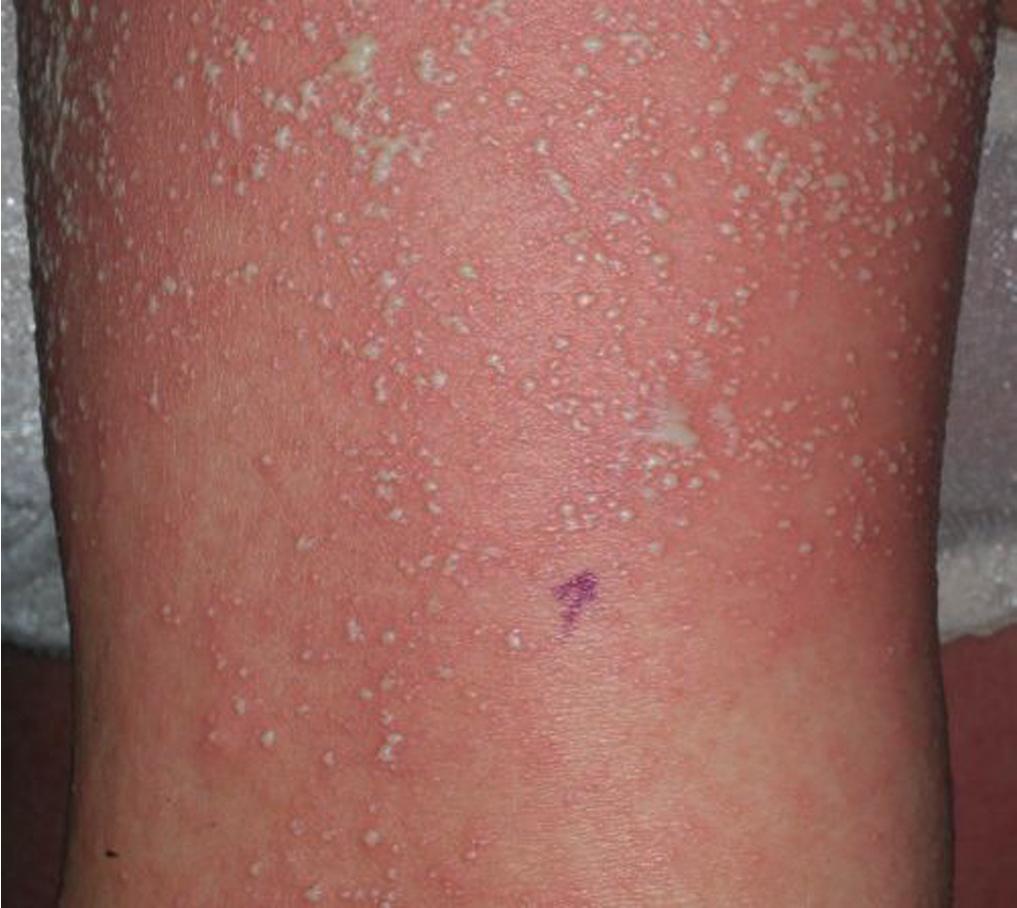
Many cytotoxic agents have been identified as causing a multitude of cutaneous adverse reactions. Although a complete discussion is beyond the scope of this book, two of the more common reactions present as reactive erythema of the hands and feet. Neutrophilic eccrine hidradenitis is classically associated with cytarabine exposure and presents as asymptomatic to painful edematous plaques on the hands and feet. Histology is diagnostic with neutrophilic infiltrate surrounding eccrine glands. These lesions may develop an acneiform appearance and may spread to seborrheic areas of the trunk and face ( Fig. 7.10 ). Hand-foot syndrome (also known as palmoplantar dysesthesia syndrome) is most commonly associated with cytarabine, fluorouracil, and multi-kinase inhibitors. This condition typically presents as highly painful edematous plaques on the hands and feet, with a predilection for fat pads. The lesions can progress to bullae and peeling acral skin.
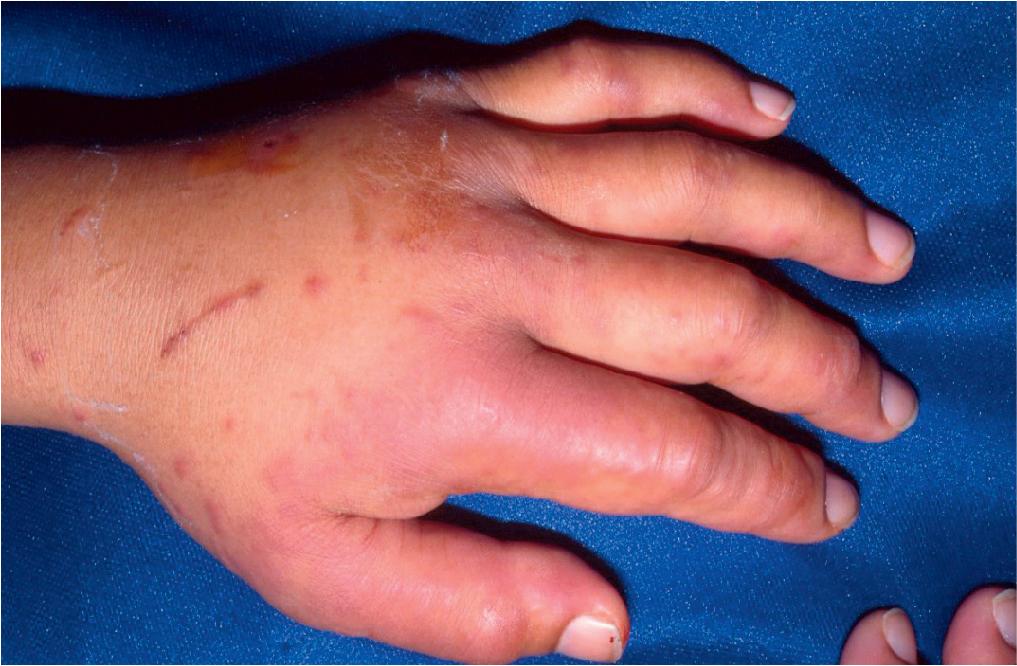
A number of viral infections have cutaneous manifestations that provide a clue to the diagnosis. In some, the skin rash is the major finding. Early recognition of distinct exanthems also helps differentiate viral infections from drug reactions, bacterial and rickettsial rashes, and other reactive erythemas.
In the early twentieth century, clinicians commonly referred to childhood exanthems by number. Scarlet fever and measles were known as “first” and “second” disease, but the two rashes were frequently confused. Rubella was established as an entity distinct from measles and known as “third” disease. In 1900, Duke described “fourth” disease, which probably does not represent a distinct condition, but a combination of rubella and scarlet fever. “Fifth” disease is recognized today as erythema infectiosum, and roseola finishes off the numbered exanthems as “sixth” disease. Many other viruses produce distinct reaction patterns in the skin. Infections from herpes- and poxviruses are readily diagnosed by their characteristic vesiculobullous eruptions, while infections from picornaviruses (which include the enteroviruses) are well recognized for their morbilliform exanthems.
Viruses trigger exanthems by a number of mechanisms. Direct infection of the skin occurs in varicella, enteroviruses, and herpetic infections. Other rashes, such as measles and rubella, probably result from a combination of viral spread to the skin and host immunologic response. Some host–viral interactions are activated by exposure to certain drugs, exemplified by the generalized exanthem that occurs in over 95% of individuals with Epstein–Barr virus infection who receive ampicillin.
In the pre-vaccine era, measles and rubella were common, and their exanthems became a paradigm for other “morbilliform” rashes. Although the usual late-winter to early-spring epidemics have been interrupted by widespread vaccination in industrialized nations, starting in the early 2000s failure to immunize significant numbers of children has resulted in intermittent and increasing outbreaks in the United States.
Measles (rubeola, red measles, 10-day measles) is a highly contagious, potentially severe illness with a prodrome characterized by fever, malaise, dry cough, coryza, conjunctivitis, and severe photophobia ( Fig. 7.11 a). Several days into the course, diagnostic Koplik spots appear on the buccal and labial mucosae ( Fig. 7.11 b). These lesions consist of 1–3 mm diameter and bluish-white papules surrounded by red halos, which increase in number and fade over 2–3 days. Unfortunately, this characteristic enanthem is often transient and goes unnoticed.
On the third or fourth day of illness, the exanthem first appears on the face as an eruption of blanching, red macules and papules, which spreads cephalocaudally over 3 days and ultimately involves the palms and soles ( Fig. 7.12 ). Once generalized, lesions become confluent on the face, trunk, and extremities in succession. Older lesions commonly develop a rusty hue from capillary leak and hemosiderin deposition. The rash begins to fade after 3 days and clearance is complete 3 days later, for a total duration of 10 days for the illness. Widespread desquamation may appear 1–2 weeks after resolution of the rash.

Patients are contagious 4 days before the exanthem until 4 days after it appears. During the illness, fever may be persistent and severe. Generalized adenopathy is common. Morbidity and mortality are highest in patients compromised by hereditary or acquired immunodeficiency, and in developing countries in which malnutrition is rampant (supplementation with vitamins, particularly vitamin A, may reduce the risk of death and complications). Potential complications that result from primary viral infection or secondary bacterial infection include conjunctivitis, otitis media, pneumonitis, meningitis, acute encephalitis, and obstructive laryngotracheitis.
Atypical measles is an unusual syndrome that occurs in individuals who received a killed measles vaccine, when it was available between 1963 and 1967, and are subsequently exposed to the measles virus. Unlike typical measles, the exanthem begins and remains primarily on the extremities and often develops a petechial component. Koplik spots are absent, fevers are high, and pneumonitis is usually severe. This disorder probably represents a hypersensitivity reaction to the virus and is most frequently confused with Rocky Mountain spotted fever and collagen vascular disease.
Rubella (German measles) is known as 3-day measles because the pink exanthem, which mimics a mild case of measles, usually evolves over 1–3 days. In fact, nearly 25% of patients may have only mild upper respiratory symptoms with little or no rash.
Rubella is typically associated with several days of low-grade fever, adenopathy, headache, sore throat, and coryza. In young children, fever may last for less than 24 h. Forchheimer spots consist of transient, small, red papules on the soft palate and are seen in some patients at the beginning of the rash. This enanthem helps differentiate this otherwise non-specific eruption from other viral exanthems.
As with measles, peak incidence occurs in the late winter and early spring. Serologic testing may be useful to make a specific diagnosis, particularly if the patient is pregnant. Although complications are rare in children, the fetus is particularly vulnerable to intrauterine infection, with complications that include spontaneous abortion, diffuse cataracts, microphthalmia, glaucoma, and congenital heart disease. Up to 25% of infected newborns develop severe, disseminated disease with jaundice, pneumonitis, meningoencephalitis, bony abnormalities, thrombocytopenia, blueberry muffin lesions (extramedullary erythropoiesis), and a morbilliform exanthem. Babies with congenital infection may shed virus in urine, stools, and respiratory secretions for up to 1 year, and should be isolated from other infants and pregnant women.
In 1983, erythema infectiosum (or fifth disease) was linked to human parvovirus B19. Since then, investigators have defined the clinical features and epidemiology of infection in normal and compromised patients.
In its most commonly recognized clinical presentation, viral infection presents in children of school age with an asymptomatic “slapped cheek” erythema on the face and a lacy or reticulated, blanching erythema on the trunk and extremities ( Fig. 7.13 a–d). Although the exanthem usually fades over 2–3 weeks, lesions may recur for up to 3 months, especially when cutaneous blood flow is increased and after fever or vigorous physical activity.
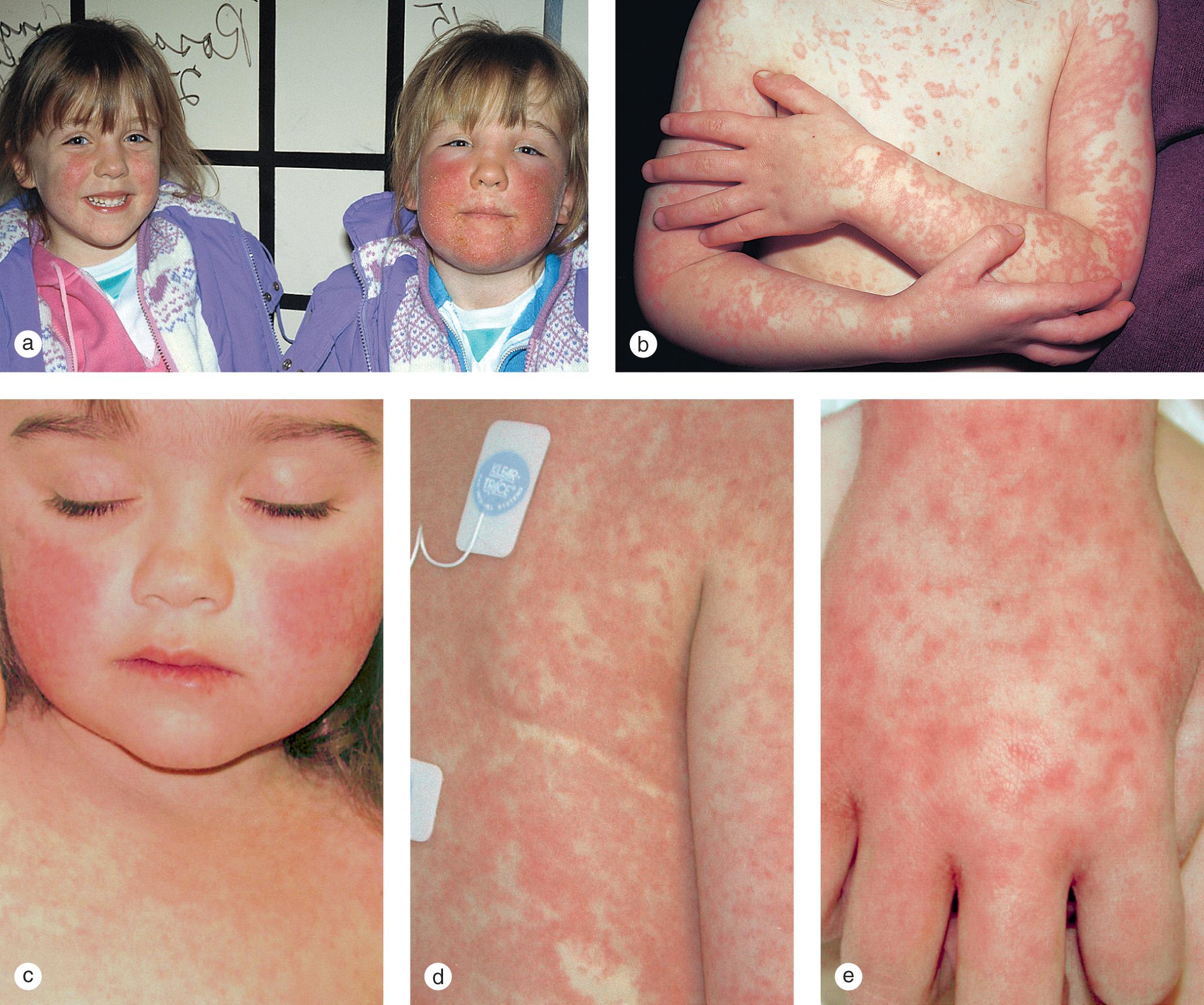
The prevalence of B19 antibody is about 5–10% in children under 5 years of age and rises to over 50% in adults. Human volunteer studies suggest that the virus is spread in respiratory secretions. After an incubation period of 5–7 days, infectivity peaks during the viremia, which lasts 5–7 days. The end of viremia is marked by a rise in IgM and then IgG antibody and followed 2–5 days later by the appearance of the rash. Consequently, the risk of infection is low when the exanthem is diagnosed, and children can remain in school.
Associated symptoms, which include fever and arthralgias, are usually mild or absent in young children. However, arthralgias or frank arthritis may be severe in adolescents and adults. At least a quarter of patients with serologic evidence of disease do not develop the exanthem, and the arthropathy may develop before, after, or without the rash.
Early in the infection most patients experience a transient reticulocytopenia for 7–10 days and a clinically insignificant drop in hemoglobin level. This phenomenon, however, may trigger an aplastic crisis in patients with severe hemoglobinopathies. The virus has also been implicated as a cause of hydrops fetalis in pregnant women with no other evidence of clinical disease. However, recent reports suggest that parvovirus can rarely cause fetal malformations. In hereditary or acquired immunodeficiency syndromes, B19 may produce persistent infection and chronic, life-threatening anemia.
Human parvovirus B19 has also been isolated from children and adults with papular-purpuric gloves and socks syndrome ( Fig. 7.13 e). Although this painful, itchy erythema, edema, and purpura of the palms and soles occurs most commonly in the spring at the peak of the human parvovirus B19 season, it has also been associated with other viruses including Coxsackie virus B6 and HHV6. Red papules reminiscent of Koplik spots and erosions may also develop on the tongue, palate, and buccal mucosa, and fever and arthropathy are variable. Treatment is symptomatic, and the syndrome usually resolves in 1–2 weeks.
The reticulated exanthem of erythema infectiosum may be easily confused with livedo reticularis, thus some distinctions between these entities are required. Livedo reticularis is a persistent, lacy, blanching, violaceous erythema that occurs in primary and secondary forms ( Fig. 7.14 ). In the idiopathic variant of livedo reticularis, lesions are symmetric and widespread with poorly defined borders. Unlike cutis marmorata in neonates (another benign reticulate erythema), the pattern does not resolve with warming. Livedo reticularis occurs most commonly in young women who are otherwise healthy. The secondary variant is more common in men and has been reported in association with polyarteritis nodosa, hepatitis, syphilis, and a number of other infections, connective tissue diseases, and malignancy.
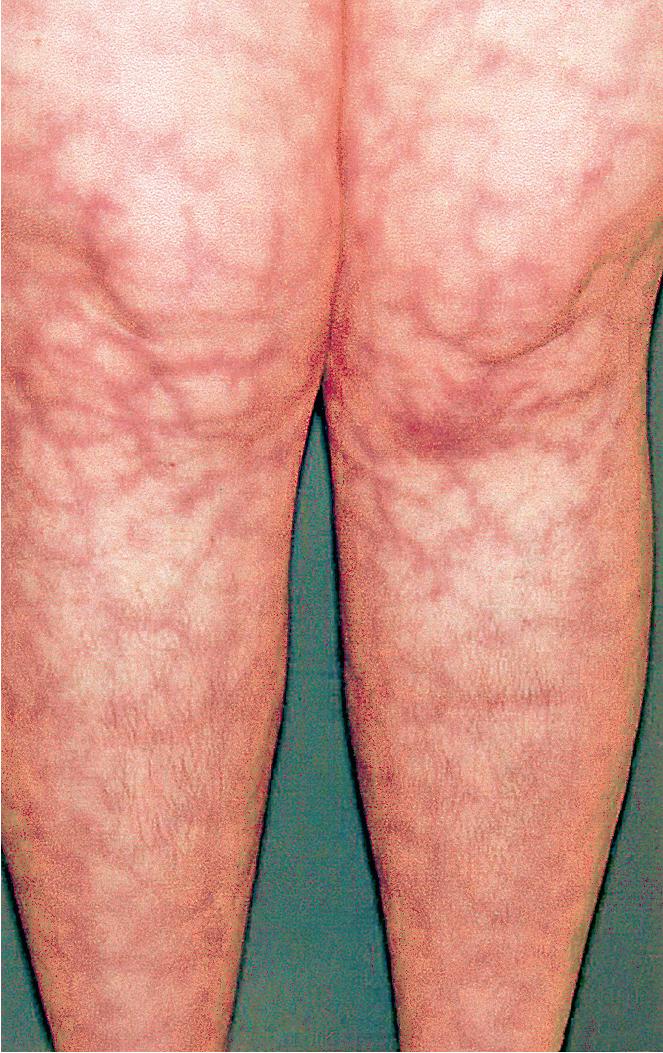
Roseola, or exanthema subitum (the “surprise” rash), has been recognized by pediatricians for over a century. The classic clinical course occurs in children between 6 months and 3 years old. After a 3–5-day illness marked by high-spiking fevers, which occasionally trigger febrile seizures, a sudden end to the fever is followed by the appearance of a widely disseminated, pink, papular rash ( Fig. 7.15 ). As in fifth disease, the end of viremia is marked by the development of the rash and a rise in antibody to the causative agent: HHV6. Consequently, the risk of infection is greatest during the febrile period and minimal after the appearance of the rash.
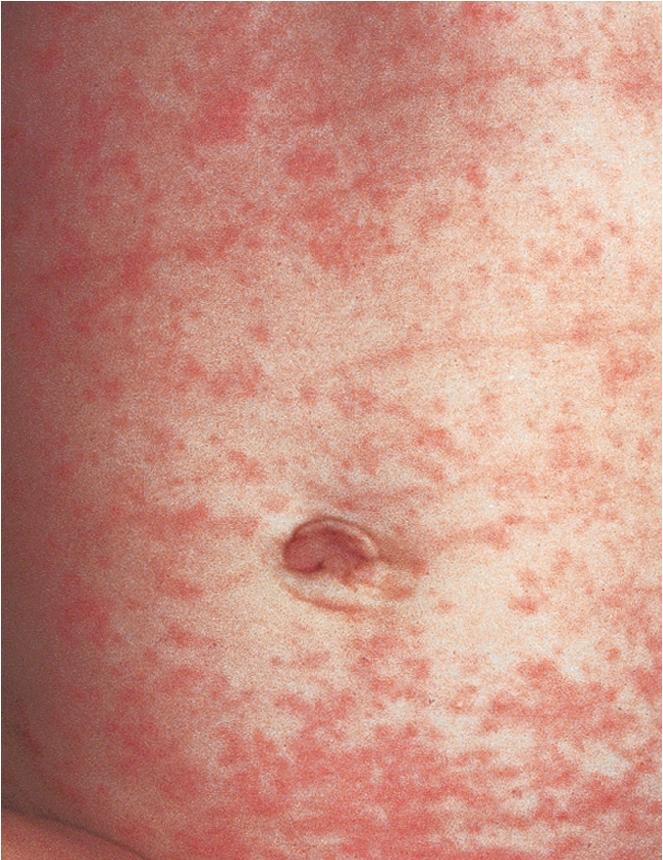
Serologic studies show an almost universal exposure of the population to HHV6. Although only one-third of infants develop clinical disease, prevalence of antibody increases from less than 10% in children under 6 months of age to 75–90% in adults. Consequently, a large number of children develop asymptomatic infection. Conversely, seroprevalence studies of febrile infants demonstrate that viral infection may commonly produce a febrile illness without a rash. A similar febrile disorder has been associated with HHV7 in some children. HHV6 has also been linked to a mononucleosis-like illness in young adults.
In 1955, Gianotti, while working in the Milan department of dermatology directed by Crosti, described a distinctive exanthem associated with anicteric hepatitis, lymphadenopathy, and hepatitis B surface antigenemia, subtype ayw . The skin rash consists of flat-topped, 3–10 mm diameter, skin-colored to red edematous papules that involve the arms, legs, buttocks, and face ( Fig. 7.16 ). Lesions on the calves and extensor surfaces of the arms may become so edematous as to appear vesicular, and occasionally frank vesicles are present.
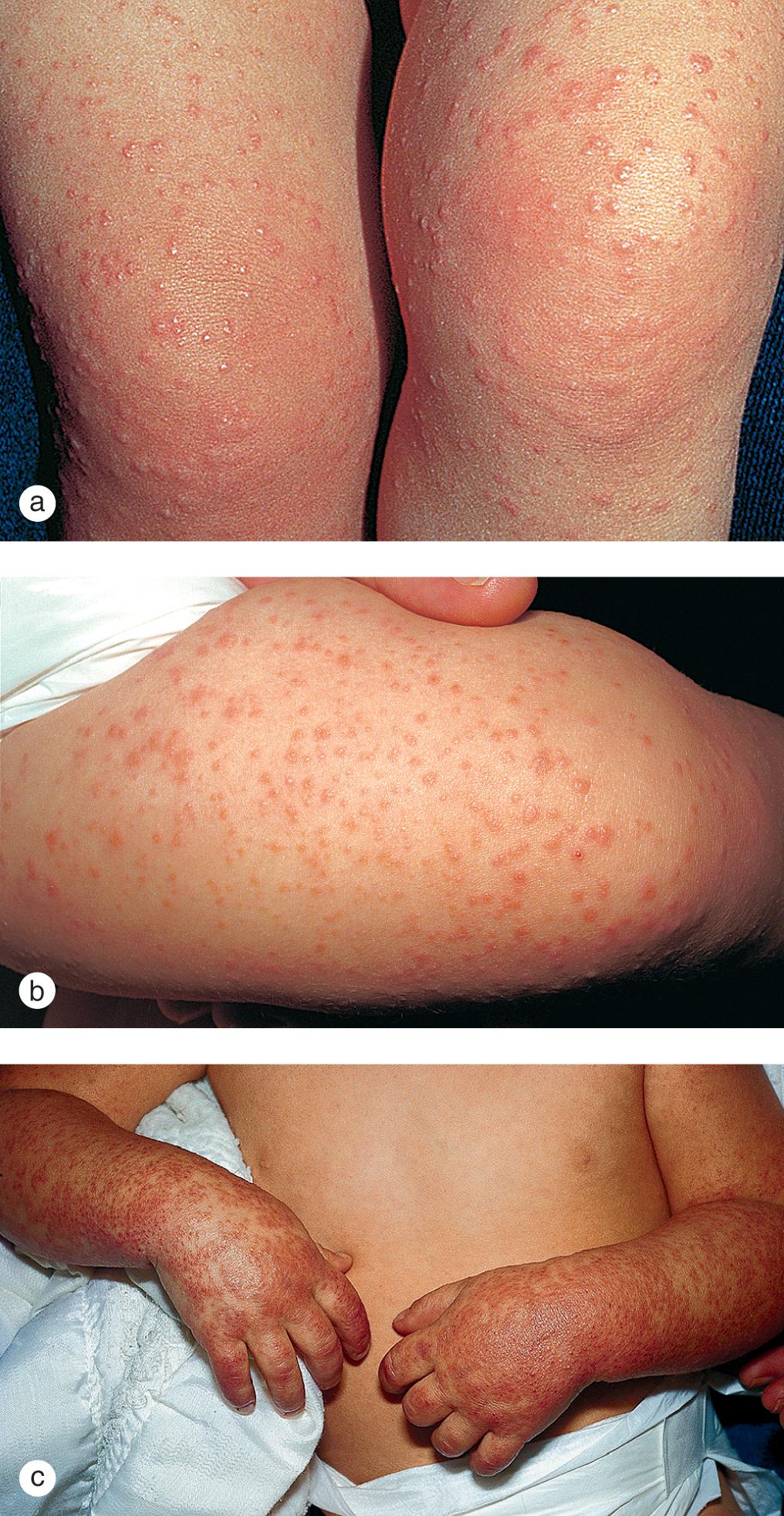
During the past 15 years, it has become apparent that most cases in the United States are caused by various viruses, including enteroviruses, respiratory viruses, and Epstein–Barr virus. As most children are asymptomatic, no treatment is necessary. However, given its clinical appearance and protracted course, parents need to be counseled that the eruption may persist for up to several months.
Papular acrodermatitis can be differentiated from lichen planus, as the lesions in papular acrodermatitis are typically asymptomatic versus the severe pruritus seen in lichen planus. A negative history of recent drug exposure excludes a lichenoid drug eruption. Other viral eruptions may also be confused with papular acrodermatitis. Unfortunately, the histopathology is not specific and shows focal spongiosis and exocytosis in the epidermis overlying a perivascular, lymphocytic, dermal infiltrate.
Exanthems associated with the enteroviruses are quite variable and usually follow a shorter incubation period than the classic viral exanthems. Although they occur all year round, the incidence peaks in the late summer and early fall. Morbilliform, vesicular, petechial, and urticarial eruptions are variably present, usually in association with fever ( Fig. 7.17 ). Other symptoms may include meningitis, conjunctivitis, cough, coryza, pharyngitis, and pneumonia. Hand-foot-and-mouth disease is a distinctive entity associated with papulovesicular lesions on the palms, soles, palate, and (not infrequently) trunk, particularly the buttocks. The typical incubation period for development of this syndrome is 3–5 days, and it is important to note that the enanthem can occur without the exanthema and vice versa. Coxsackie viruses A1-6, A8, A10, A16, and A22 and enterovirus 71 have been identified in patients with this syndrome. With the recent introduction in the United States of a new Coxsackie A6 virus from Asia, there has been a shift in the exanthem to a papulovesicular-crusted eruption with prominence of lesions on the arms and legs, and around the mouth and diaper area, with relative sparing of mucous membranes. The rash also tends to koebnerize with increased aggregation of skin lesions in areas of pre-existing trauma, such as in patches of eczema, burns, and cuts and scrapes.
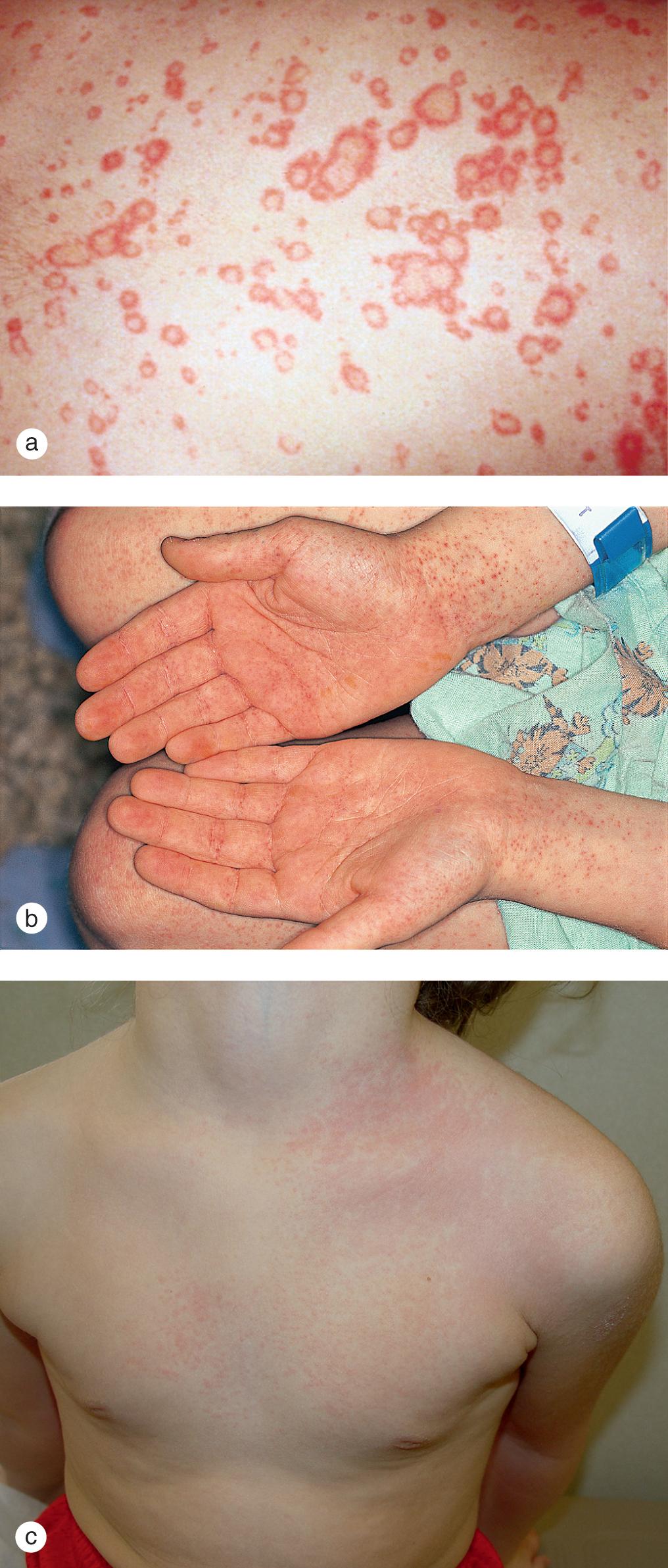
Unilateral laterothoracic exanthem (asymmetric periflexural exanthem of childhood) ( Fig. 7.17 c) is another distinct clinical pattern that may be triggered by a number of organisms, including the enteroviruses. The asymptomatic or minimally pruritic morbilliform or scarlatiniform eruption usually begins near one axilla and, although it often remains predominant on the initial side, spreads over the trunk in infants and preschool children. The mean age of onset is 2 years, and girls are affected twice as often as boys. Lesions usually heal without scarring over 5 weeks. Although there is no diagnostic test, a unique eccrine lymphocytic infiltrate is identified in skin biopsies.
Papulovesicular rashes may be differentiated from varicella zoster and herpes simplex infections by obtaining a polymerase chain reaction (PCR) swab of a lesion for both HVS (herpes simplex virus) 1/2 and VZV (varicella zoster virus) testing. Additionally, Tzanck smear, cultures, and serologic studies help to make a specific diagnosis. Although meningococcal infections tend to peak during the winter and spring, occasionally cases occur during the summer and fall enteroviral season. Consequently, the child with a petechial exanthem and presumed enteroviral meningitis must be evaluated carefully to exclude a bacterial infection.
Infection with cytomegalovirus, Epstein–Barr virus, and respiratory viruses may be associated with macular, morbilliform, or urticarial exanthems, which are difficult to differentiate from drug rashes. Children who require medications and develop intercurrent viral infections and resulting morbilliform exanthems may remain on their medications while under close observation. These minor viral exanthems usually fade in several days, while drug reactions tend to persist or intensify. However, drugs must be discontinued in any patients who develop urticaria, angioedema, SJS/TEN, or other signs of progressive allergic reactions.
The rash of scarlet fever provides a model for a number of important disorders that must be differentiated by other signs and symptoms. Bacterial toxins, viral infections, drugs, and Kawasaki syndrome have all been associated with scarlatiniform eruptions.
Scarlet fever is characterized by a fine, red, papular, sandpaper-like rash that begins on the face and neck and generalizes to the trunk and extremities within 1–2 days ( Fig. 7.18 ). The skin is warm and flushed, and some patients complain of mild pruritus. Circumoral pallor is typical but not diagnostic. The rash ranges from a subtle pink to fiery red color and usually follows the onset of streptococcal pharyngitis by 24–48 h. Pastia lines are the accentuation of the rash from linear petechiae, which occurs in the flexural creases of the arms, legs, and trunk ( Fig. 7.18 b). Other associated symptoms include nausea, vomiting, fever, headache, general malaise, and abdominal pain. The palms, soles, and conjunctivae are usually spared. In classic cases, the pharynx is beefy red with palatal petechiae, purulent tonsillitis, and tender, cervical adenopathy. Early in the course the lingual papillae poke through a white membrane (white strawberry tongue; Fig. 7.19 a). Shedding of the membrane by days 4–5 results in a bright red, strawberry tongue ( Fig. 7.19 b). In many patients, the throat infection is mild or completely asymptomatic. Scarlet fever may also be associated with streptococcal impetigo.
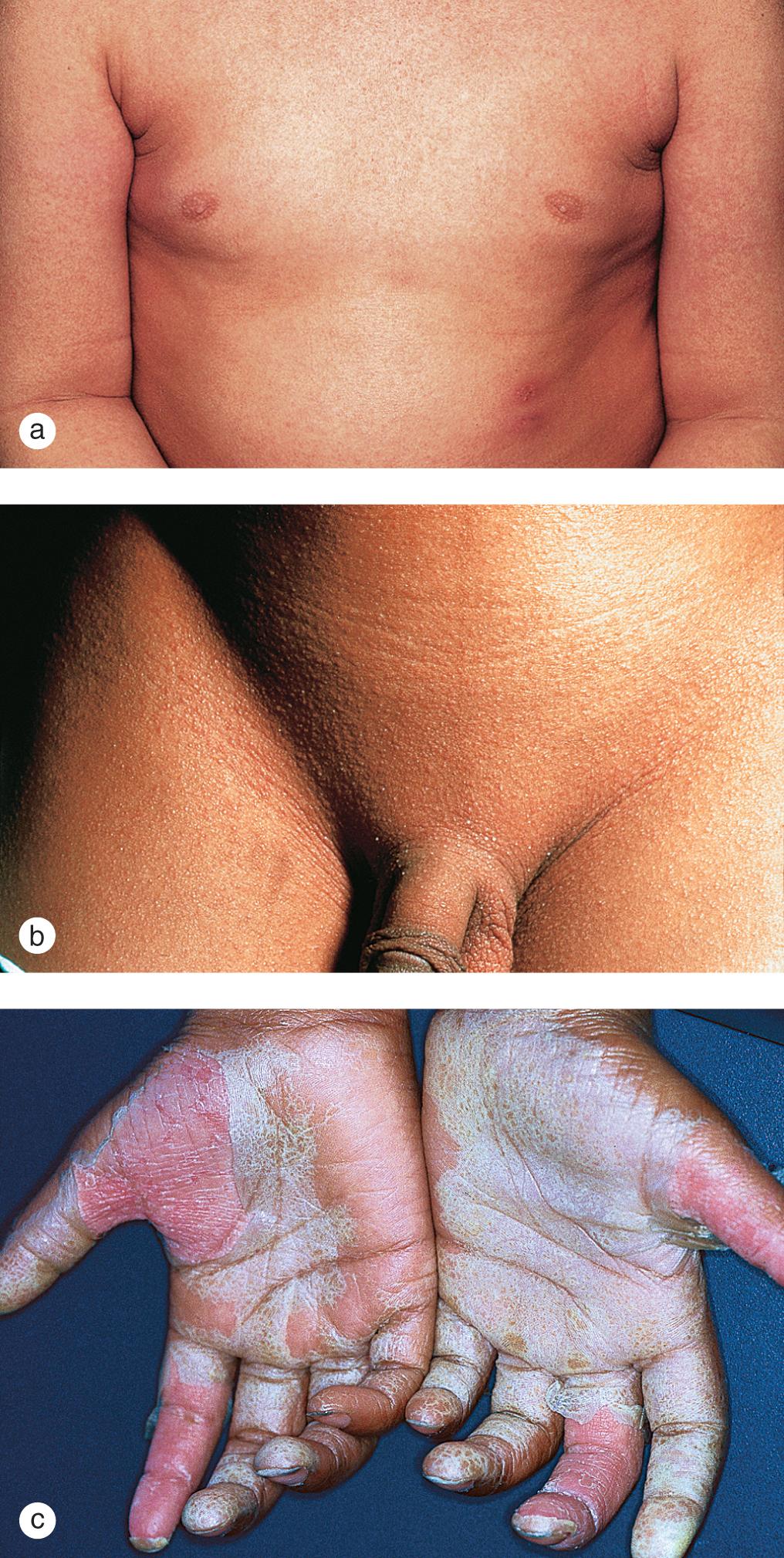
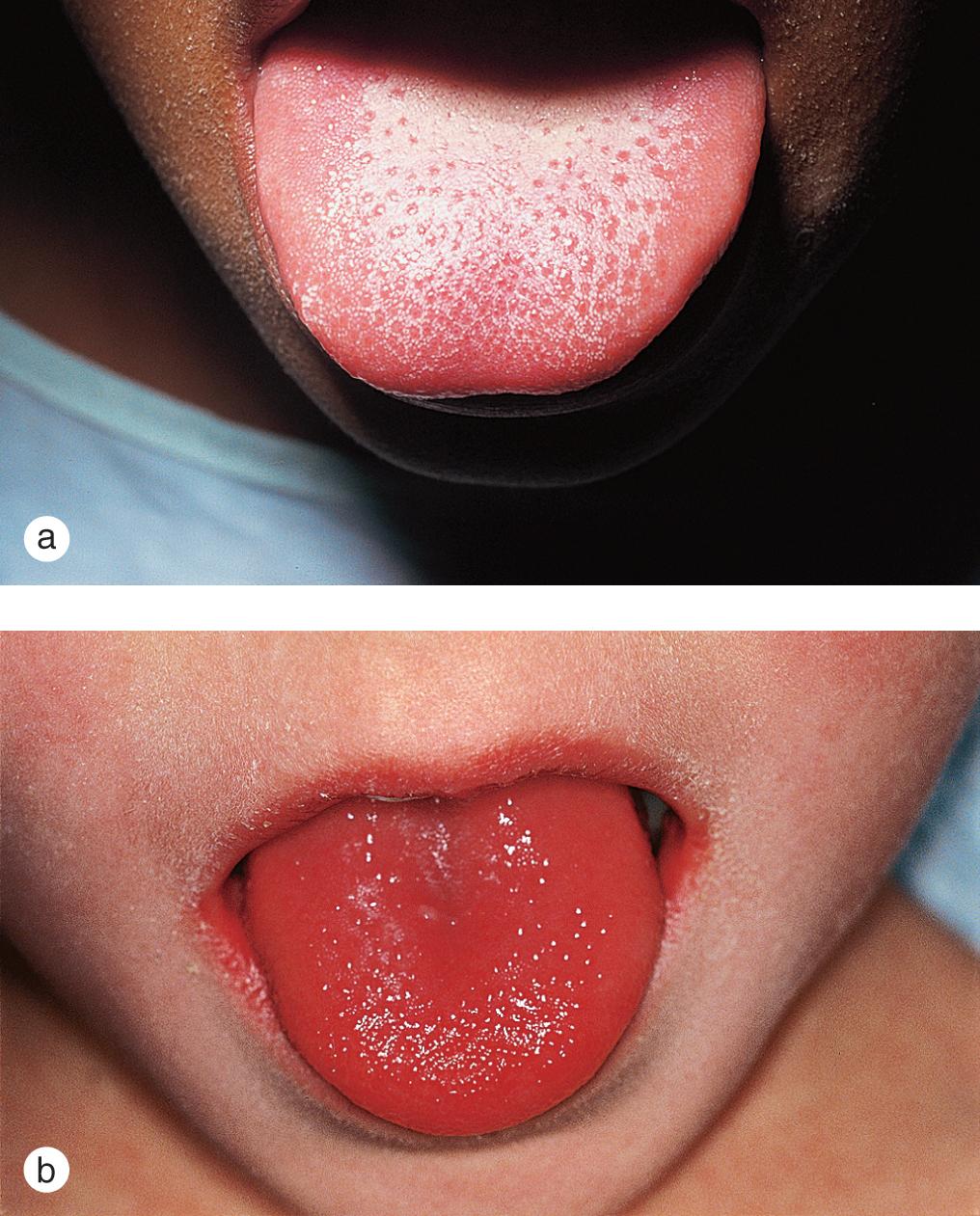
The rash is triggered by one of three antigenically distinct erythrotoxins, which are produced by most strains of Group A β-hemolytic streptococci. Development of antibodies against the streptococcal organism and erythrotoxin is protective and results in resolution of the symptoms and rash within 4–5 days. This is followed 1–2 weeks later by generalized desquamation, which is particularly marked on the fingertips and toes ( Fig. 7.18 c). Although both oral and cutaneous infections with nephritogenic streptococci can trigger glomerulonephritis, only pharyngeal infections have been associated with subsequent development of rheumatic fever. Treatment of patients with amoxicillin or penicillin (erythromycin or other macrolides in penicillin-allergic patients) may shorten the course of fever and other symptoms. If antibiotics are initiated within 10 days of the onset of pharyngitis, the risk of rheumatic fever may be reduced from 3% to less than 1%. Unfortunately, early treatment of nephritogenic strains has not been shown to decrease the incidence of poststreptococcal renal disease. Moreover, asymptomatic pharyngeal infection may escape detection until after the development of late complications.
Several other toxin-mediated syndromes may be confused with scarlet fever. Children with staphylococcal scarlet fever develop a rash, which may be indistinguishable from streptococcal disease. Nikolsky sign may be present, but pharyngeal signs are usually absent. Cultures from the typical purulent conjunctivitis or the oral or nasal pharynx invariably demonstrate Staphylococcus aureus . Unlike streptococcal scarlet fever, desquamation begins early in the course (by day 2) and is complete within a week. The clinical signs and course probably vary with the source of the infection, amount of staphylococcal exotoxin present, and host response. A similar eruption may accompany toxic shock syndrome. However, the eruption is usually accompanied by hyperemia of the conjunctivae, oral and vaginal mucosa, a strawberry tongue, and severe multisystem disease. The early findings in both staphylococcal scalded-skin syndrome and TEN may mimic scarlet fever. However, the presence of Nikolsky sign and progression to widespread sloughing of skin quickly differentiate these disorders. Scarlatiniform viral exanthems may occur with a number of different organisms. The course may be similar to that of scarlet fever and can only be differentiated by serologic studies and the absence of streptococci in throat or skin cultures.
Although the exact etiology of Kawasaki syndrome is unknown, the epidemiology, clinical findings, and course suggest an as yet unidentified infectious agent. Cases occur all year round, with slight peaks in the late spring and late fall. Epidemics have also been reported. Although all races may be affected, the increased incidence among Japanese and intermediate risk of Japanese Americans supports a genetic predisposition.
Kawasaki syndrome is defined clinically by the presence of five out of six major criteria, which are fever (usually unresponsive to antipyretics for at least 5 days), conjunctivitis, pharyngitis, erythema and edema of the hands and feet, rash, and adenopathy ( Fig. 7.20 ). The acute phase, which lasts 10–14 days, begins with an abrupt onset of high fever and extreme irritability. A rash usually appears shortly after the fever and may take the form of a scarlatiniform, morbilliform, or urticarial exanthema, or a combination of them. It is commonly accentuated in intertriginous areas, where maceration and scaling may be prominent, particularly on the perineum and inguinal creases ( Fig. 7.20 f). Facial swelling and pallor are commonly present. Other findings during the acute phase include non-purulent, conjunctival injection, erythema, edema, and cracking of the lips, palatal erythema and a strawberry tongue, painful erythema and edema of the hands and feet, and painful, unilateral cervical adenopathy. Arthritis, diarrhea, abdominal pain, aseptic meningitis, hepatitis, urethritis, otitis, and hydrops of the gallbladder may also be present. The improvement in acute-phase mucocutaneous and systemic symptoms is often so dramatic that many practitioners look to this response to confirm their clinical diagnosis.
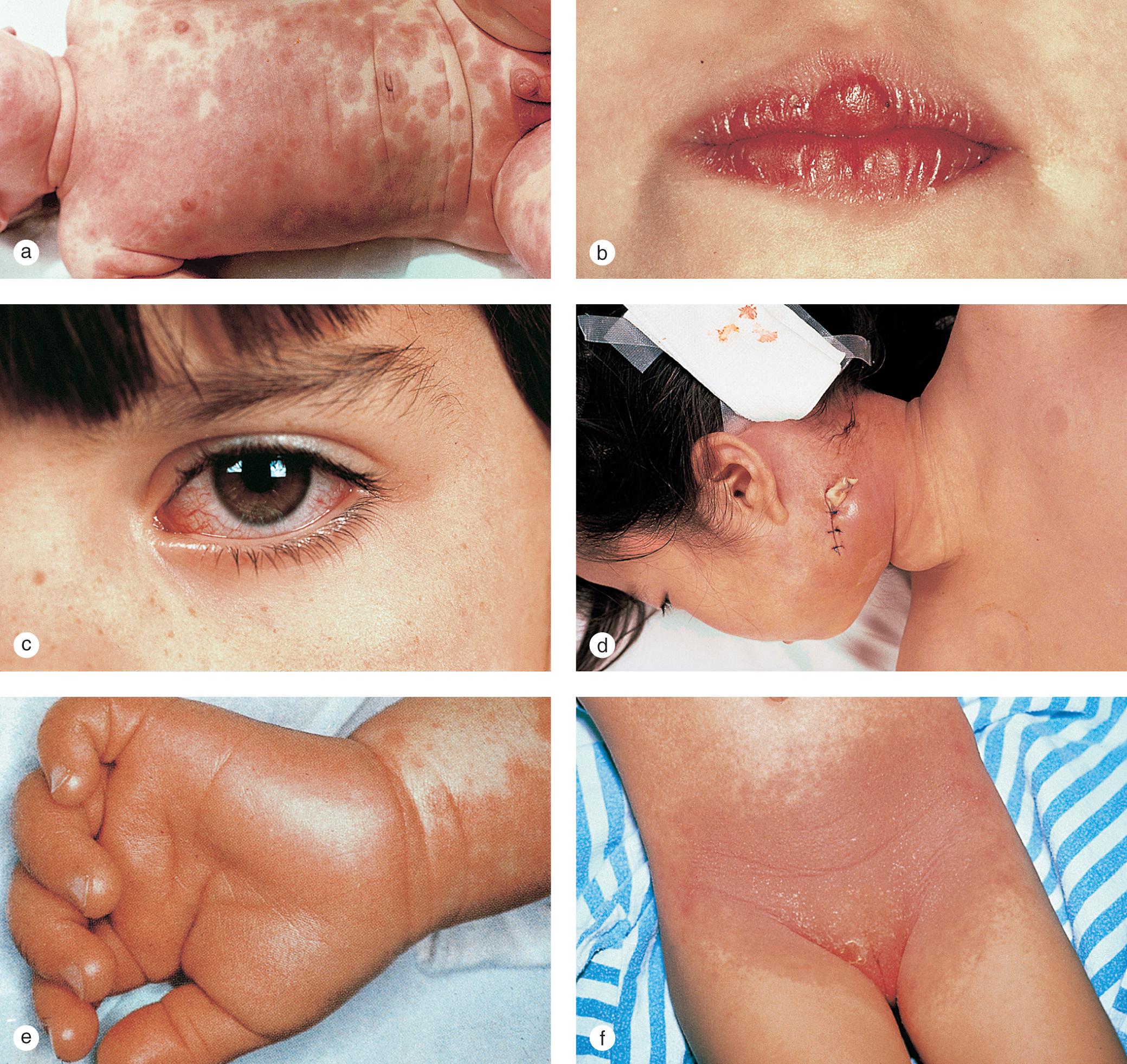
The subacute phase begins 10–14 days after the onset of symptoms, as the fever and rash improve. It is during this period that carditis associated with coronary angiitis becomes apparent, particularly in untreated patients. By 3 weeks, most patients experience a thrombocytosis of over 1 million platelets/cm 3 , which may further increase coronary morbidity. Widespread desquamation occurs 1–2 weeks after resolution of the rash, particularly over the fingers and toes, where the skin is shed in large sheets. Although no specific laboratory tests are available for Kawasaki syndrome, leukocytosis is common and acute-phase reactants, which include C-reactive protein and erythrocyte sedimentation rate, are markedly elevated.
The convalescent phase begins in the fourth or fifth week and ends when the sedimentation rate returns to normal. Children require cardiac re-evaluation at least through this stage and for a year or more if aneurysms are detected.
The differential diagnosis includes viral exanthems, toxin-mediated bacterial disorders, connective tissue disease, and a number of other reactive erythemas. Acral erythema and edema, one of the classic findings during the acute phase of Kawasaki syndrome, is also typical of papular acrodermatitis and other viral exanthems, Rocky Mountain spotted fever, erythromelalgia, pernio, and acrodynia (pink disease). Papular acrodermatitis is easily differentiated from Kawasaki syndrome by the lack of fever and other systemic symptoms. The specific criteria and course of Kawasaki syndrome usually help to differentiate it from other viral infections that produce urticarial lesions and edema of the extremities. The findings in rickettsial diseases are also distinctive.
Early recognition is important to minimize the risk of coronary artery abnormalities. Intervention with intravenous gamma globulin, 2 g/kg given over 10–12 h as a single infusion, can reduce the incidence of coronary artery aneurysm formation from 20% to less than 4%. Over 75% of patients are under 4 years old and 50% less than 2 years of age. High-dose aspirin is typically added to this treatment regimen, given as 30–100 mg/kg total daily until fevers have been absent for 48 h. However, meta-analysis has shown that the addition of aspirin does not affect the development of coronary artery aneurysms.
Erythromelalgia is an unusual entity characterized by paroxysms of painful erythema of the hands and feet, which last for minutes to hours ( Fig. 7.21 ). Patients often complain of warmth of the distal extremities followed by marked erythema and pain, which is initially improved by elevation, and then only by increasing periods of immersion in cold water. Although the primary variant is usually familial and inherited in an autosomal dominant pattern, secondary erythromelalgia may be triggered by polycythemia vera, lymphoproliferative disorders, hypertension, and disorders associated with hyperviscosity. When the underlying condition is treated, symptoms improve. Unfortunately, primary disease is often recalcitrant and cold-water exposure results in an “immersion foot” with progressive vascular injury, recurrent ulcerations, and secondary bacterial infection. The inherited form of erythromelalgia has been linked to mutations in voltage-gated sodium channel Nav1.7, which is expressed in peripheral nociceptors.
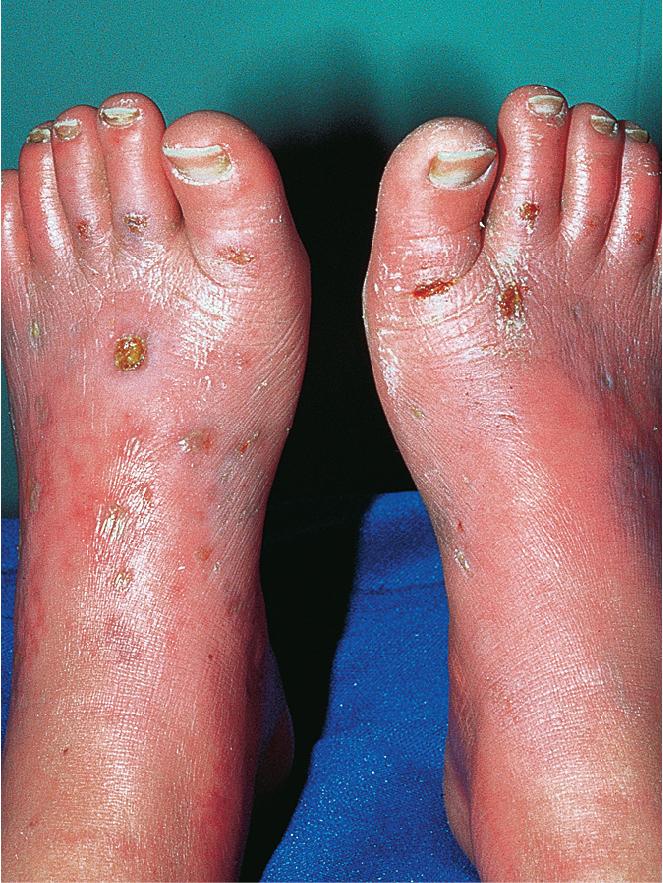
Erythromelalgia and the following acral erythemas can usually be distinguished from chemotherapy-induced hand-foot syndrome based on history and symptoms.
Pernio, also known as chilblains, results from cold exposure, usually just above freezing, and recurrent trauma. It is commonly reported in temperate climates, where women and children are most commonly affected. Typical lesions consist of painful nodules and plaques that overlie bony prominences on the hands and feet ( Fig. 7.22 ). Histopathology demonstrates intense edema of the papillary dermis and endothelial swelling associated with a mononuclear, perivascular infiltrate. Inflammation may extend to vessels in the deep dermis and fat. Thin girls and young women with a history of cold hands and feet, equestrians, scuba divers, and individuals who participate in fall and winter sports are particularly prone to developing lesions. The risk of recurrences can be reduced by keeping the distal extremities warm and protected from trauma. Patients should be instructed to avoid cold and damp exposures to the hands and to wear dry gloves or mittens in any cold environment. Chilblains should be distinguished from child abuse (in which cold exposure is not the primary trigger) and chilblain lupus. One should suspect child abuse when clinical findings seem inconsistent with environmental exposure, such as geographic lesions or highly asymmetric distributions (e.g., only one foot being involved). Chilblain lupus may represent an overlap of pernio and lupus, but in time, many patients with chilblain lupus develop features both clinically and histologically of discoid lupus in addition to their pernio lesions.
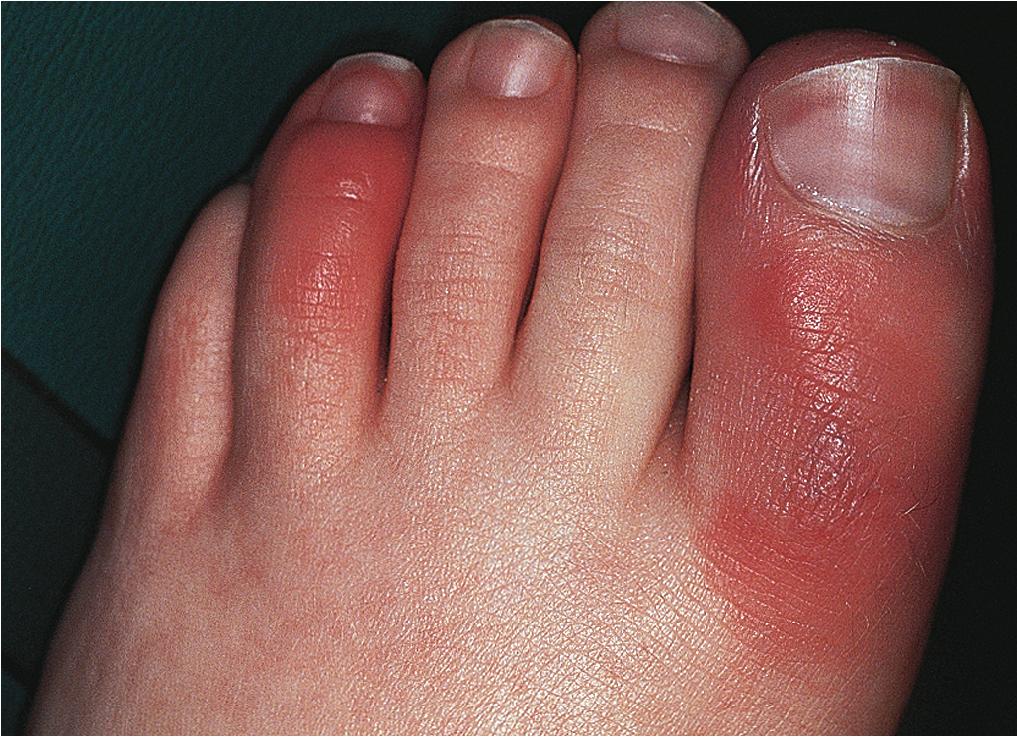
Acrodynia, or pink disease, occurs in infants and toddlers as a result of chronic exposure to mercury. Painful, persistent erythema and swelling of the hands and feet are accompanied by other signs of sympathetic stimulation, which include tachycardia, hyperhidrosis, restlessness, and irritability. Treatment is directed toward removing the source of mercury exposure and chelation therapy.
Bleeding into the skin may be an innocent finding in minor trauma or the first sign of a life-threatening disease. Early diagnosis and treatment, when necessary, requires that the practitioner recognizes and carefully evaluates any patient with purpura.
Cutaneous hemorrhage can be differentiated from hyperemia that results from increased blood flow through dilated vessels by failure of the hemorrhagic area to blanch when pressure is applied across the surface (diascopy). Diascopy can be demonstrated by pressing the skin apart between the thumb and index finger or by applying a glass or plastic slide. Pinpoint areas of hemorrhage are called petechiae; large, confluent patches are referred to as ecchymoses. Purpura results from extravascular, intravascular, and vascular phenomena.
Trauma is the most common cause of extravascular purpura in children. Non-blanching, purple patches caused by accidental trauma vary from a few millimeters to many centimeters in diameter and are usually located over bony prominences, such as the knees, elbows, the extensor surfaces of the lower legs, forehead, nose, and chin. Petechiae are only occasionally present in otherwise healthy children, although they may occur on the face and chest after vigorous coughing or vomiting.
The presence of purpura on protected or non-exposed sites, such as the buttocks, spine, genitals, upper thighs, and upper arms, suggests the possibility of non-accidental trauma. In some cases, the shape of the bruise gives a clue as to the weapon used to inflict the injury.
Scars, sun damage, nutritional deficiency, inherited disorders of collagen and elastic tissue, and other factors that decrease the tensile strength of the skin may increase the risk of bruising caused by extravascular phenomena, even after minor trauma ( Fig. 7.23 ).
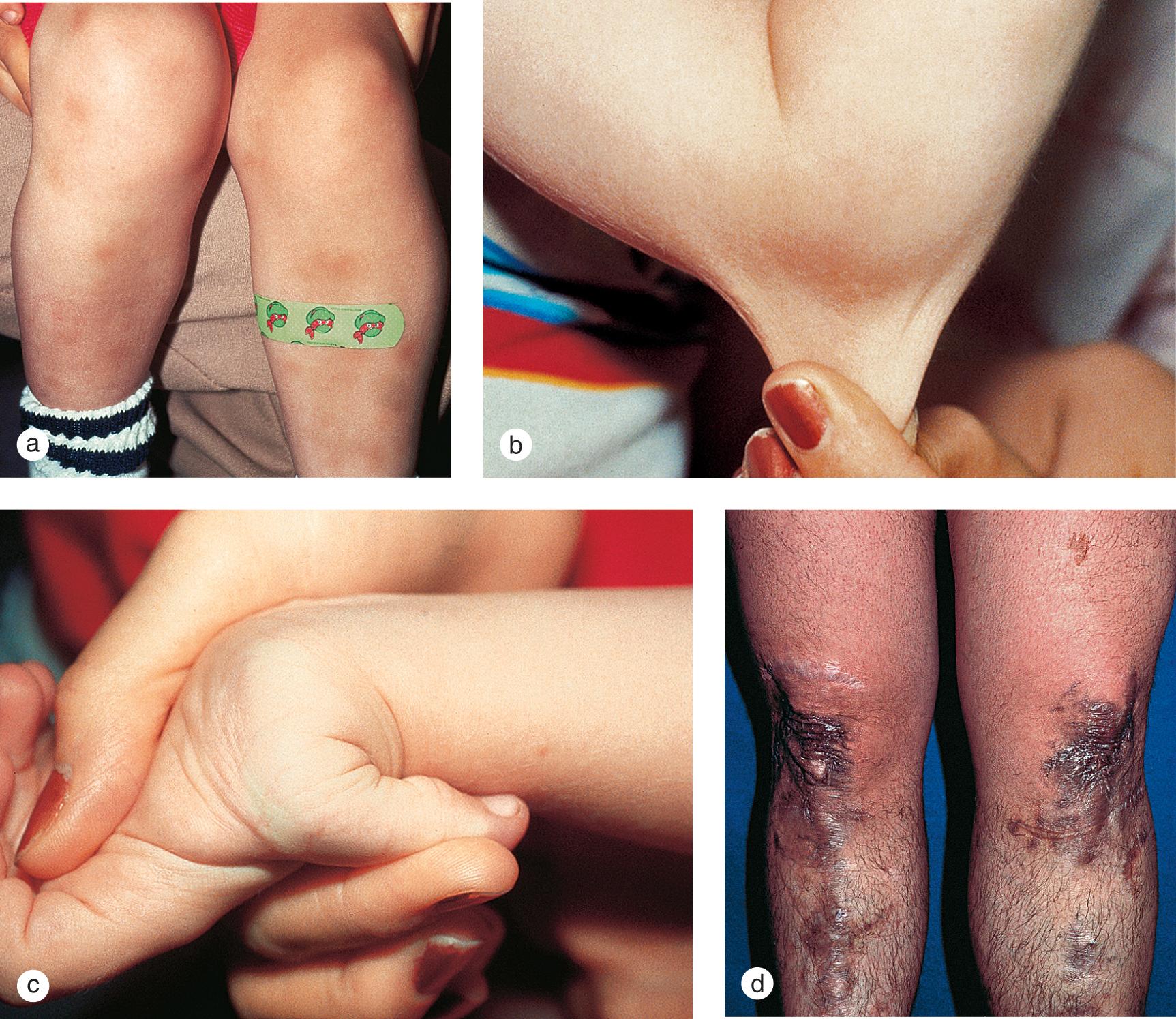
Intravascular purpura results from any disorder that interferes with normal coagulation. Petechiae and ecchymoses are present on the skin, mucosal bleeding may be seen, and in severe cases bleeding may occur in the kidneys, gastrointestinal tract, and central nervous system. Among the causes are immune thrombocytopenic purpura (ITP), acute leukemia, aplastic anemia, sepsis, nutritional deficiencies, and clotting factor deficiencies.
Become a Clinical Tree membership for Full access and enjoy Unlimited articles
If you are a member. Log in here